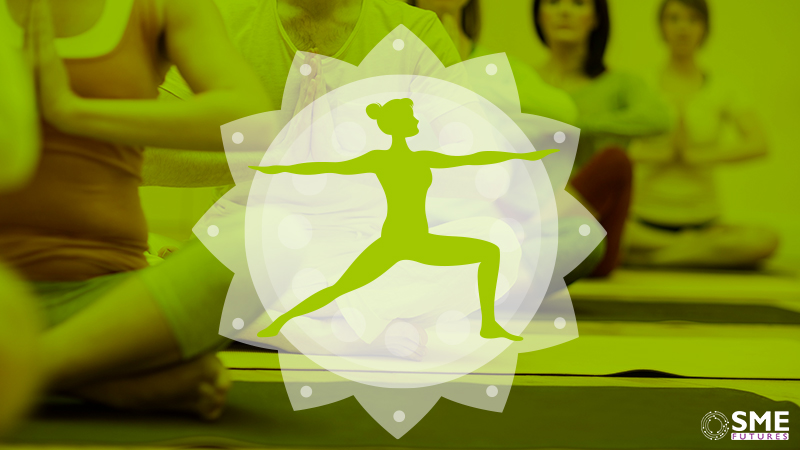When it was asked on a social media platform “What does wellness mean to you?”. Here is what the netizens had to say. A platform user, Revati Khadse writes, “Wellness means a way to keep your health good so that you remain fit”. Another user Ira Smith views wellness as crucial to live a quality life. She says, “Wellness matters because everything we do and every emotion we feel relates to our well-being. In turn, our well-being directly affects our actions and emotions”. While one more user Russell explains it as, “Wellness is a state of optimal well-being, not simply the absence of illness, but an improved quality of life resulting from enhanced physical, mental and spiritual health”.
It is clear that wellness can hold different meanings for different individuals. For some, it is physical fitness, while for others, it is more about a holistic approach towards relaxation and happiness. The NABH (National Accreditation Board for Hospitals & Healthcare Providers) too defines wellness as, “A state of a healthy balance of the mind and body that results in overall well-being”. A FICCI EY report on wellness defines it more scientifically as, “Wellness, unlike health, is more than an absence of diseases and involves a holistic perspective of an individual. It involves a wide range of human experiences such as personal growth, family, education, community development, medical care, coaching and work”.
Well, wellness isn’t a new concept; it has always been there. Strong economic growth in the last few years has resulted in a transition in dietary habits, which has led to a steep rise in lifestyle-related ailments. A 2018 global survey carried out by Cigna TTK Health Insurance, conducted across 23 markets, noted that, nine out of 10 Indians are stressed, with 95 per cent of them being millennials. The study also cited work as one of the major triggers for shooting stress levels. Stress is a common problem that has manifested many such health complications as insomnia, poor nutrition, obesity, physical inactiveness and heart diseases (non-communicable diseases); wellness is becoming the cornerstone for the quality of life.
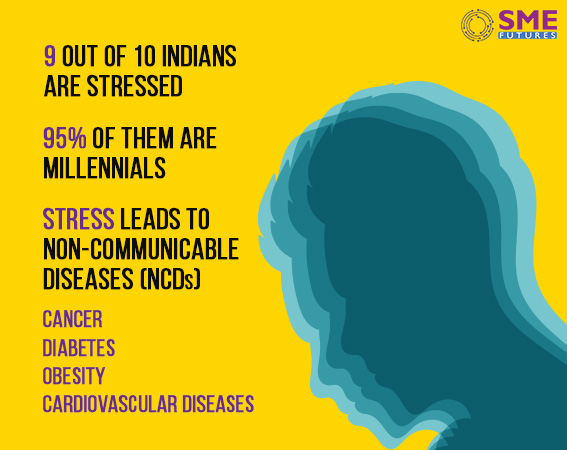
Major factors driving the wellness industry are India’s young population and rising disposable incomes, among others. Lately, it has also evolved as a trend to visit wellness centres; for instance, a nice back rub or a foot massage does the trick for city-based Sharad Agarwal, leaving him refreshed for an all-consuming month at work. Every month, he spends about five per cent of his earnings at spas and salons, getting head and neck massages, pedicures and sometimes even full body spas if he is in a mood to splurge. “The massages facilitate better blood circulation, relieving me of body aches due to the long hours of sitting at work,” the 27-year-old says.
Likewise, fitness lover Aditya Pahuja is a member of a well-known fitness startup that includes fitness regimen of popular Bollywood actor. “I always make sure to go to the gym daily even if I am busy. It makes me energetic and helps me stay fit after a long day at the office”. He has taken a yearly gym package, which is affordable and includes discounts regular. These were some of the instances of how people, especially youngsters, are more prone to leading a lifestyle that includes wellness in their daily lives as fitness regime or luxurious ‘me time’.
While talking about wellness, more people were of the opinion that wellness is about an active pursuit of activities, lifestyle and choices that lead to a state of holistic health. In addition to that, the industry is bringing out more interactive and customised solutions to attract consumers. A yoga trainer in Greater Noida commented on wellness being set as a trend. She said, wellness is no longer considered as a luxury. According to her, “Consumers today are very well-aware of holistic approaches and are setting aside quality time to acquire wellbeing. Whether it is metro or non-metro cities people are willing to pay a premium for wellness experience”. She told us that people are more interested in taking different packages that are customisable according to their time.
Outdoor holiday packages including fitness and yoga activities that offer digital detox are also in trend these days. Dr. Madhurima Gupta of the centre for wellness at Delhi’s Sarvodaya Hospital and Research Centre also confirms the trend. In her view, regulated spa and salon sessions are necessary in addition to the daily health routine that one might follow to maintain functional efficiency. “Today’s lifestyle is such that people have money but no time for themselves. In such situations, spas, salons and gyms are becoming extremely popular because these are places where people can get away from their phones and work, de-stress and relax”, she said.
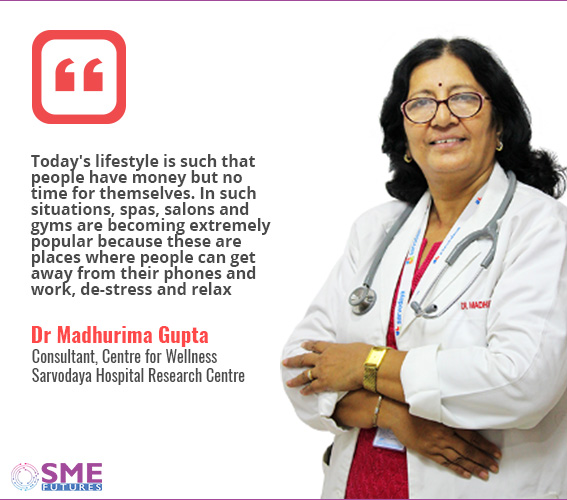
State of the sector
Indeed, with people becoming aware of their personal wellness and fitness, a whole new segment comprising consumers, providers, facilitators, adjacent industries and the government has been evolved. The segment combines sports, fitness and wellness, and has gained immense popularity in India from its nascent unstructured beginning in the early 1990s to a comprehensive ecosystem today. A 2016 report by FICCI and EY Consulting named “Value Added Service – Wellness and Preventive Healthcare” revealed that, during FY15, the Indian wellness industry was valued at around ₹ 85,000 crores.
While a combine report from Research firm, Praxis Global Alliance and YourNest, a venture capital fund on the emerging market of Sports, Fitness and Wellness (SFW) market in India highlights the potential of the market. According to the report, SFW market is set to grow from $35 billion in 2016 to $90 billion by 2022 at a CAGR of 17 per cent in India. The report titled “Health is Indeed Wealth” confirms the trend of growing health awareness with 45 per cent people prioritising healthy lifestyles, while 60 per cent and 21 per cent disapproving of smoking and drinking, simultaneously. The report also highlights the catalysing impact on the peripheral products and services industry that will create 2.5 times more opportunities in the SFW segment.
Madhur Singhal, Managing Director with Praxis Global Alliance, says in the report, “Millennials want to live better, eat better and feel better, and SFW-led brands will grow in appeal due to the promise of a more fulfilling consumption experience”. Rapid urbanisation is further fuelling this trend. India’s urban population, as per census 2011, was 31.16 per cent, growing at a CAGR of 1.2 per cent. Urban infrastructure is being revamped with the government planning smart cities. All these factors together are shaping the future of the wellness industry in India.
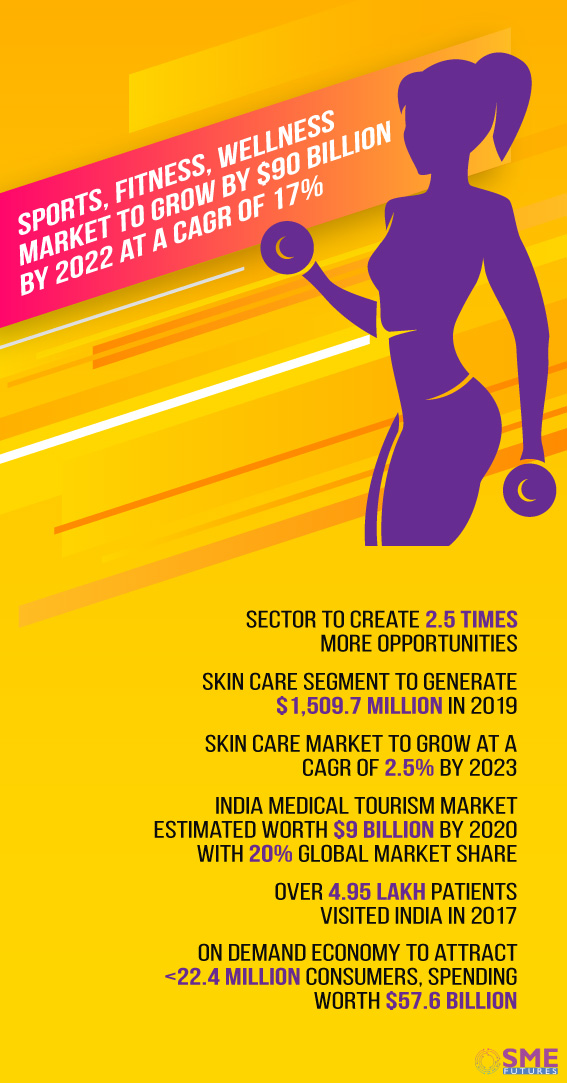
It is evident that the consumers mainly comprise a young population with rising income levels and the increasing need to look good and feel good, which has led these young consumers to seek wellness solutions to meet lifestyle challenges. With significant scope for penetration especially in areas like nutrition, rejuvenation and fitness, the Indian wellness market has a huge business opportunity waiting to be harnessed. Tapping out the opportunity, well-known beauty and wellness brand VLCC is working to open 14 wellness centres and five skill development institutes in Tamil Nadu this year. The company already operates 11 centres in the state. On choosing particularly Tamil Nadu, Vandana Luthra, Founder of VLCC Healthcare Ltd, explains the reason in a company statement, “Tamil Nadu is an important market for us and we are extremely happy with the uptake of the beauty, health and wellness segment in the state. The network expansion has been well-planned to reach out to every customer not just in Chennai, but also in Coimbatore and Madurai”. Taking into consideration that the state with a population of around 79 million ranking high in obesity, VLCC is offering the latest body sculpting and scientific weight-loss procedures like DNA Wellness and Coolsculpting to customers apart from advanced beauty and skin care treatments.
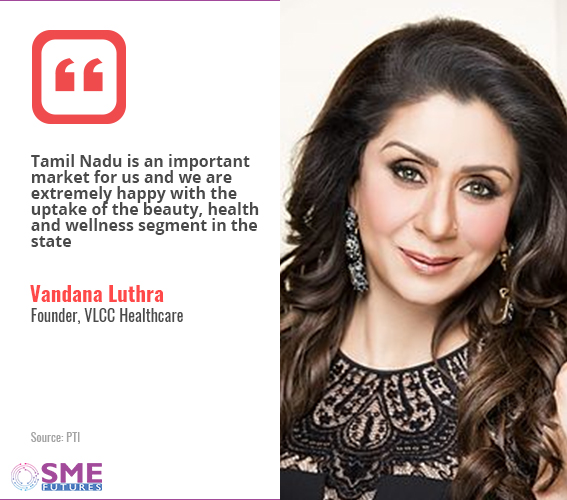
A pool of opportunities for SMEs
As the wellness sector is characterised by research, innovation and product development, as well as strong competition, needless to say that the big multinational companies are dominating the space but small and medium businesses especially startups are also establishing themselves. MSME comprises at least 80 per cent market share of the sector. Almost 75 per cent of the product market is occupied by over-the-counter (OTC) products such as digestives, health food and pain balms. Small businesses are tapping the sector as they play a key role in bringing out innovations to the market, quickly and efficiently.
Fast&Up is an example of one such startup that plans to bring out innovation in terms of providing intelligent nutrition solutions in the country. The brand has identified a vacuum in the market for OTC nutrition, addressing Indian needs for active living in the age group 18 to 55. The startup under the flagship sports nutrition brand Aeronutrix Sports Products Pvt Ltd is currently catering to its customers through an omnichannel strategy including online and retail stores. Its CEO Vijayaraghavan Venugopal also believes that SMEs have to be innovative to remain in the business. He says, “Much of the innovation in wellness sector originates from SMEs and to successfully compete in this industry, these companies must bring their innovations to the market”. The startup is excited about the innovative products in the pipeline. “Sports is the most exciting place to be! We will be hydrating over two lakh runners in the next 8-10 months during races across the country and will be associated with cricket world cup to be played this year,” he told us.
Similarly, Alanna, which is a four-year-old skin care brand, started from a home kitchen. Founded by entrepreneur Rashi Bahel Mehra, the brand manufacturers natural and vegan skincare products. The brand has products that are affordable for the average Indian consumer and is positive about its presence in the pool of big beauty players in the Indian market. Mehra feels that although the Indian market is competitive due to a wide variety of beauty product players, their innovative concept makes them different from others. “There are a lot of players in this category; even international brands have entered the market. But people are getting more conscious about skincare, and the importance of organic beauty is growing, thus acquiring customers depends on your product and approach”.

According to Statista data, revenue in the skin care segment amounts to $ 1,509.7 million in 2019. The market is expected to grow annually at a CAGR of 2.5 per cent by 2023. It is mostly driven by economic optimism and well-travelled, exposed and connected people. People are now also aware of the harmful effects of chemicals in the long run on an individual’s skin, thus, have started opting for skin-safe and skin-friendly products made from natural ingredients, SLS and are paraben free. While skincare firms, domestic or international, are also initiating different kinds of services and solutions emphasising on skin wellness.
Currently, the brand is hosting 28 products like under-eye gels, dry scrubs, lip scrubs and the charcoal range, and most of its clients come from the millennial range. The firm has recently introduced a Volcanic Clay Mask and is developing some interesting products that will be launched in the coming months. “Our client retention rate is around 80 per cent, and our goal is to retain the existing clientele while gradually building a larger loyal customer database”, she says.
Mehra opines that there are immense opportunities for small and medium businesses in this segment, but one should always maintain the quality of products to sustain in the market. “Adapting to the rapid changing market and staying relevant is also very important, and if you crack this code, there is ample room for everyone”.
The alternative treatment options in the wellness sector have further provided a significant edge to small businesses in the country over competitors in Asia. Hence, medical tourism is growing, too. According to government data, in 2017, over 4.95 lakh patients visited our country to get alternate medical treatments. While FICCI IMS Health India report reveals that India has nearly 18 per cent of the global medical tourism market. In the sense, the Medical Value Travel (MVT) was pegged at $ 3 billion in the year 2015 and is estimated to grow at a CAGR of 15 per cent. Also, it has been estimated that India’s medical tourism industry could be worth $ 9 billion and account for 20 per cent of the global market share by 2020. Niti Aayog identified the MVT as a major source of foreign exchange earnings. It is no doubt that India is slated to become a hub of medical tourism by 2020 due to compact insurance cost, pharmaceuticals and travel without diminishing the service quality. Due to the increasing number of patients, the demand for low-level laser therapy (LLLT) and thermal therapy is likely to increase, and the alternative healthcare market is poised to get a boost.

Gak Sung World, which caters to alternative medicine, is the manufacturers of technically advanced machines based on laser and thermal therapy. Currently, their products are being used by wellness firms globally. Through unique marketing strategy, the company is providing free of cost therapy to the Indian families. Ali Asif, Managing Director at Gak Sung World India, informs us that their products are being used by the masses at demonstration centres or at home for the treatment of various lifestyle diseases. “People are moving towards nature. Anything that’s free of chemicals and toxins. We mostly get people who have suffered a lot and could not find a single remedy or relief”.

The clinical application of laser therapy is effective in treating tendon strains, chronic back pain, cold sores, burns and strokes, and is used and recommended by many health professionals. Moreover, the growing prevalence rate of cancer has also made cold laser therapy a new treatment option as it has proved to be really beneficial in curbing the pain from chemotherapy. The company has already set up around 80 operational centres across the Indian cities that include many tier 2 and tier 3 cities. “The company has given alternate health therapies to four million and envisions to help 10 million patients globally by 2022”, informs Asif.
Health & Wellness @Doorstep
A report by Harvard Business Reports, reveals that, the on-demand economy attracts more than 22.4 million consumers annually with spending somewhere in the region of $ 57.6 billion. All these on-demand services include various services where a big chunk denotes to the wellness sector. Now, seeing the tremendous growth, wellness brands are entering the wagon to cater to day-to-day needs of the consumers. As there are several players competing with each other for the same target audience, hyperlocal businesses are establishing themselves by giving on-demand doorstep services. They are constantly going one step ahead to make consumers’ lives more comfortable. Mehra of Alanna views it as a necessary step and says, “It just reinstates that consumer stays to be the king with changing market scenarios, and keeps getting more and more powerful. With the right planning and market intuition, a business can really leverage doorstep services”.
Homecare is one of the new buzzwords among the health and wellness sector, says Venugopal. “The demand is increasing for at-home medical services, especially among the geriatric population of the country; an increasing number of healthcare startups are now seen foraying into this lucrative market”. According to Harvard Business Reports, 49 per cent of on-demand app consumers are millennials, while 30 per cent are between the ages of 35 to 54. These figures only create ample business for the segment, which is especially dominated by the unorganised players and is now witnessing professionals setting their foot in it.
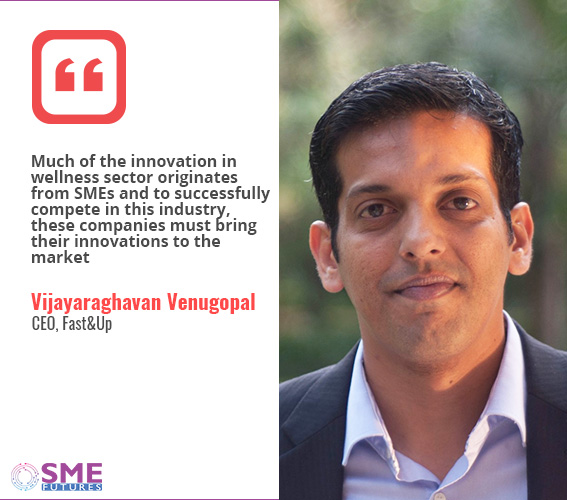
Sector suffers Skill Gap
Skill gap is one of the major challenges in lots of sector and wellness is no exception. With a shift in focus towards quality of service, the industry has been looking to hire skilled labour to sustain growth. FICCI estimates that the sector requires 600,000 additional skilled personnel over the next five years. However, their availability is a concern. Effective monitoring of the industry is a challenge and, on hindsight it seems as though the initial attempts at quality accreditation have not been impactful. Furthermore, most of the training courses offered by unorganised small time players are not recognised by the industry, and the candidates do not receive a premium for completion of these courses. According to the NSDC and KPMG reports, workforce requirement in all five different segments is as follows:
- In beauty and salon segment, workforce requirement is expected to grow from 62 lakhs in 2017 to 121 lakhs in 2022.
- In beauty products and counter sales sector, workforce requirement is expected to grow from 10 lakhs in 2017 to 18 lakhs in 2022.
- In the fitness segment, workforce requirement is expected to double from 85,000 in 2017 to 112,000 in 2022.
- In the slimming segment, workforce requirement is expected to increase from 27,000 in 2017 to 43,000 in 2022.
- In the rejuvenation segment, workforce requirement is expected to grow from just 76,000 in 2017 to 213,000 in 2022.
Although the government has been contributing with various initiatives to train the labour force with Skill India and similar initiatives, due to social economic challenges such as, social stigma, absence of social safety, migration, etc, the sector remains void of skilled people. To compensate for the gap, several organised players such as VLCC, LoReal, Anand Spa Institute, Enrich Academy, Talwalkars and others have also established training centres to meet the captive requirements in collaboration with the government.
To promote skill development in the sector, the Beauty and wellness Sector Skill Council of India participate in the national certification and reward scheme ― the STAR (Standard Training Assessment and Reward) Scheme ― and aims to reach out to a million youngsters. The programme rewards employees undergoing training with an average reward of ₹ 10,000 per candidate as incentive under the National Skill Certification and Monetary Reward Scheme (NSCMRS) contingent upon the candidate clearing the assessment with minimum 90 per cent attendance.
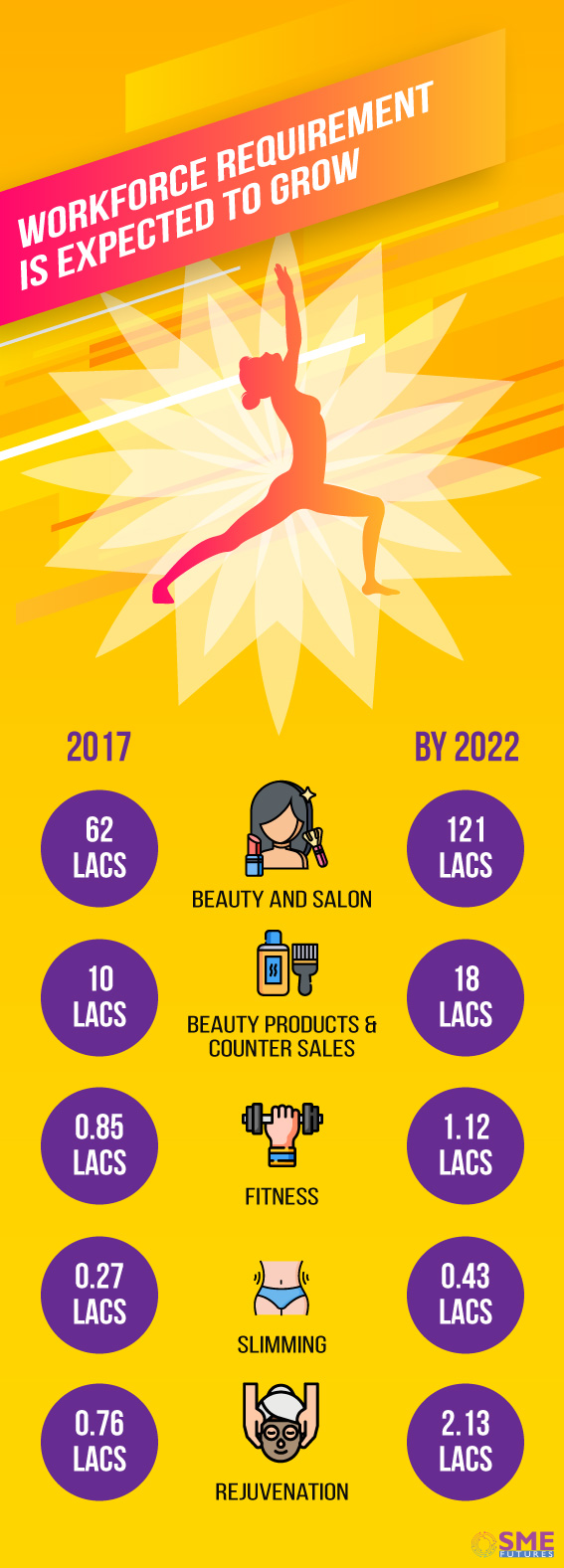
In addition to this, the government has also set up the Ministry of AYUSH. As of March 8, 2016, as many as 3,598 hospitals and 25,723 dispensaries across the country offer alternative medicine treatment. The All India Institute of Ayurveda was set up in 2017. AYUSH information cells have also been set up in 29 countries, and an MoU has been signed with the National Health Organization of the US for the development of ayurveda and yoga. Yoga, the path to wellness, as the Prime Minister puts it, is being promoted in a big way, in perfect alignment with the government’s holistic approach to health. June 21 is being celebrated as International Yoga Day since 2015.
Overall, the wellness industry is becoming an employment generator, providing numerous business opportunities for investors. Millennials are emerging and disrupting all sorts of businesses existing globally. Independent brands have the potential of making it big in the wellness industry with lower entry barriers because of the fast-growing global set of consumers. The industry is experiencing the transformation of how people are consuming services and products. With most of the offerings becoming available online, industry players need to shift their focus towards the advanced technology for walking with the latest trends. Dr Gupta says, people have started accepting wellness as an essential aspect of life, “Good health is achieved not only through your daily habits including a healthy diet, moderate exercise, quality sleep and preventive care, but also by giving your mind and body a chance to reconnect.”

